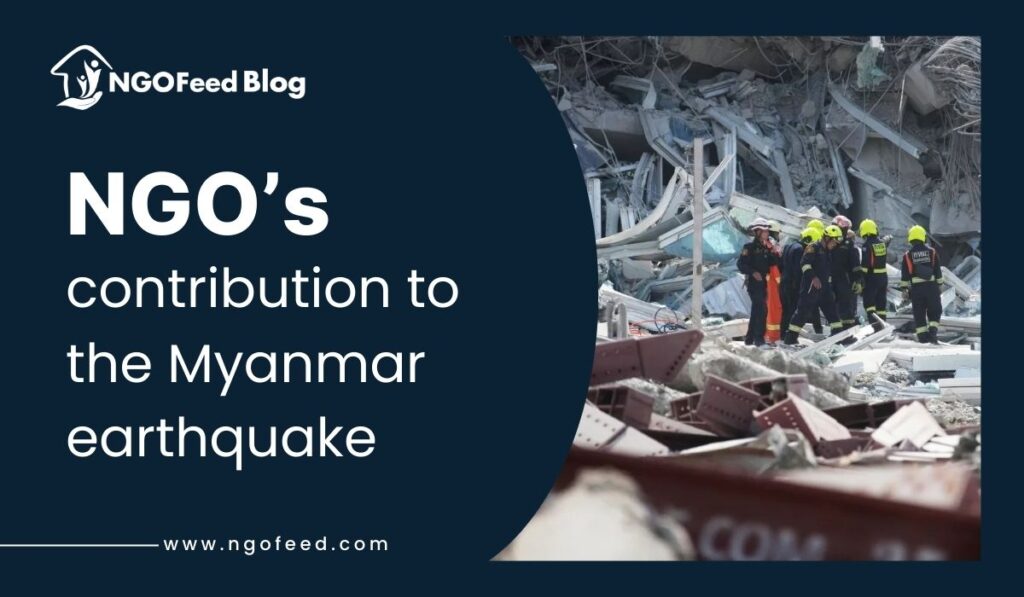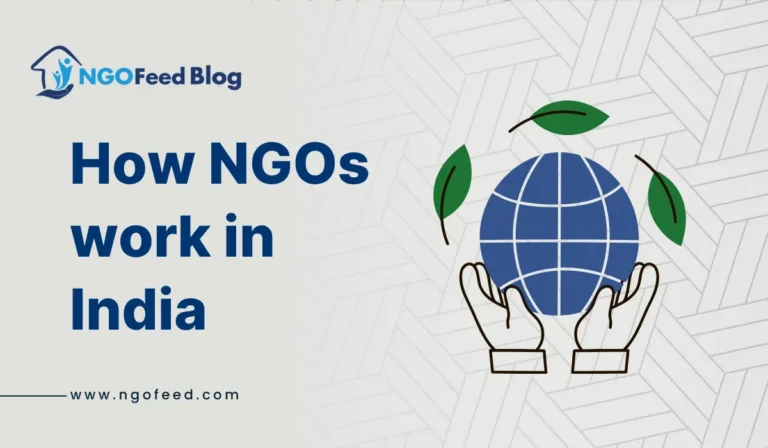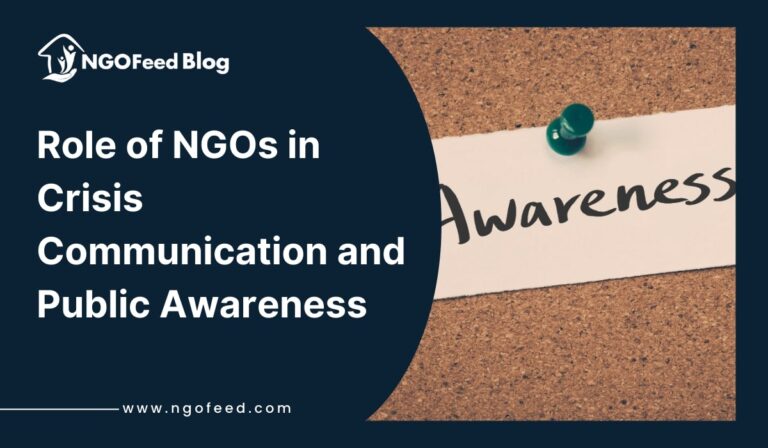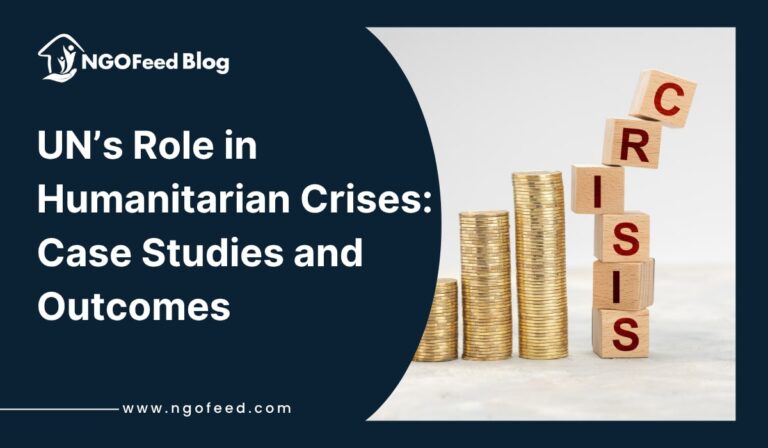NGOs Contribution to Myanmar Earthquake: The central Myanmar region experienced catastrophic destruction following the 7.7-magnitude earthquake on March 28 2025 which displaced numerous people causing a substantial casualty count. This natural disaster has forced the nation to face conditions requiring urgent humanitarian aid, which non-governmental organizations (NGOs) now deliver nationwide.
The ongoing political and humanitarian crisis in Myanmar makes assistance delivery difficult. However, various NGOs in India succeed in giving medical services and emergency housing and food provisions in addition to psychological care to affected populations. Project HOPE has deployed emergency medical teams for rapid response and international aid organizations work together with local partners to handle unstable situations in the affected region.
Response and rebuilding operations receive essential support from NGOs despite their ongoing need to overcome logistic barriers. Through international backing from China, India, and the United Nations, these organizations continuously deliver life-saving relief and long-term rehabilitation services. The vital role of NGOs becomes a light of hope for disaster-impacted people as they assist a nation already affected by internal conflicts. The ongoing support activities of NGOs are the focus of this research about their work to lessen the effects of the Myanmar earthquake and assist in the recovery process.
Table of Contents
Myanmar Earthquake (28th March 2025)– Full information here
A fierce earthquake of 7.7 magnitude struck central Myanmar close to Mandalay City at 12:50 PM local time on March 28, 2025. The earthquake struck shallow earth at a depth of 10 kilometers which worsened the extent of harm. The earthquake spanned across the region to produce seismic activity which impacted Thailand India and China.
Also Read: NGOs in Disaster Management
Casualties and Damage in Myanmar Earthquake
Rescue operations in Myanmar continue to reveal mounting death tolls because the earthquake caused a minimum of 144 fatalities combined with 732 injuries. The collapse of buildings together with bridges in Mandalay led to many deaths because of the extensive destruction. Almost every single building in Naypyidaw’s capital became uninhabitable because multiple structures collapsed and many roads popped up due to the earthquake damage.
An under-construction high-rise building failed during the earthquake in Bangkok Bangladesh resulting in ten casualties with sixteen injuries followed by one hundred and one people considered unaccounted for. Everyone in the city experienced a state of panic as emergency personnel ordered everyone to evacuate.
Aftershocks and Ongoing Risk
Multiple powerful seismic events with magnitude 6.4 being the largest continued to disturb emergency operations and increase dangers to the existing structures. Officials indicated that the expectation exists for more aftershocks to occur throughout the following days.
Also Read: Role of NGOs in Environmental Protection
Response and Relief Efforts of NGOs in Myanmar Earthquake
A state emergency currently exists in areas under military rule while the government makes an unusual international appeal for help. The United Nations has dedicated $5 million towards emergency aid while China, India, and South Korea are part of the countries offering support. The affected populations receive emergency shelter medical care and food supplies thanks to efforts from non-governmental organizations that activate resources.
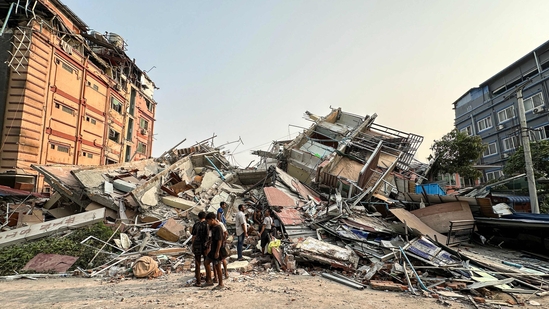
People stand past the debris of a collapsed building in Mandalay on March 28, 2025, after an earthquake. A powerful earthquake killed more than 20 people across Myanmar and Thailand on March 28, toppling buildings and bridges and trapping over 80 workers in an under-construction skyscraper in Bangkok. (Photo by AFP)
NGOs Immediate Response to Myanmar Earthquake
Non-governmental organizations (NGOs) reacted rapidly to provide fundamental support when a 7.7-magnitude earthquake hit central Myanmar on March 28, 2025. Non-governmental organizations showed their instrumental role by providing emergency medical help during the search and rescue pursuits and relief operations in the trying conditions.
Search and Rescue Operations
Local combined forces with international strategies along with authorities through NGO partnerships to run missions in regions with the worst earthquake damage. Operations to find trapped survivors concentrated on broken-down buildings that mainly affected Mandalay and Naypyidaw. The International Federation of Red Cross and Red Crescent Societies (IFRC) sent specialized teams that included search dogs alongside technical equipment for these operations. The American Jewish Joint Distribution Committee (JDC) worked together with local partners to evaluate urgent needs and facilitate rescue work.
NGOs Contribution to Myanmar Earthquake in Medical Assistance
Large numbers of casualties during the earthquake created an excessive workload that overwhelmed medical facilities in the region. Non-governmental organizations set up medical platforms that included field hospitals together with emergency medical camps to support urgent healthcare needs. Staff members of Médecins Sans Frontières (Doctors Without Borders) delivered trauma treatment while performing surgical procedures and giving advanced medical care to critically injured patients. The organizations distributed critical medical supplies which restored the used-up resources in local healthcare facilities.
Also Read: NGOs in Disaster Risk Reduction
Emergency Relief Efforts
Fundamental non-profit organizations made comprehensive efforts to meet the broader human needs of the communities affected by the disaster. Through their local partners, the JDC supplied essential supplies including food, water, hygiene kits, and other necessary items to areas severely affected by the disaster. ShelterBox used its role as an international disaster relief organization to provide emergency shelter kits for families whose homes were destroyed. The delivery of assistance was accelerated by NGOs who linked resources with international donors who seamlessly directed aid to the distressed population.
Non-governmental organizations adapt to infrastructure damage and communication limitations as they perform a vital role in the current relief operations in Myanmar. The timely actions combined with ongoing dedication from NGOs have proven essential to minimize disaster effects and assist population centers in this pivotal crisis period.
Challenges in Delivering Aid
Humanitarian aid assists the victims of the 7.7-magnitude earthquake that hit central Myanmar on March 28, 2025, yet this relief work faces substantial obstacles. Multiple hurdles in the delivery of aid emerge because of Myanmar’s unstable political situation limited logistics and poor coordination in damaged zones.
Political Instability
Since the military took power in 2021 Myanmar has experienced continuous political turmoil which produced extensive civil unrest throughout the country. The junta maintains strict control over aid distribution while creating doubts regarding how equally resources get distributed. The military’s control of the nation threatens the delivery of aid to areas that they do not control throughout the crisis. Organizations working internationally must handle intricate circumstances to send assistance throughout all affected areas while avoiding worsening current conflicts.
Also Read: Role of NGOs in Disaster Relief
Logistical Barriers
Critical infrastructure damage from the earthquake causes heavy destruction to roads, bridges, and airports which results in challenging access to transporting emergency relief to the severely impacted areas. The path to the main transportation routes in Mandalay remains blocked by fallen buildings and debris which creates delays for relief personnel and supplies to reach their targets. Efforts to coordinate assistance become more difficult because communication networks are devastated which leads to problems in need assessment together with resource distribution.

Coordination Difficulties
Civil warfare in Myanmar creates additional challenges for organizations working to provide aid in the country. The civil unrest continues to divide specific regions among resistance groups who face ongoing battlefield actions with official Myanmar military forces. Difficulties emerge due to the broken structure of control which impedes international aid organizations from performing safe operations and developing coordinated responses throughout the affected areas. Adequate protection of relief providers and passage of aid operations must be secured through careful dialogues between multiple rebel groups.
An effective response to these challenges demands combined support from international actors together with local groups and all Myanmar-based stakeholders. The provision of aid assistance depends on building independent aid delivery systems as well as achieving security agreements in affected areas and rebuilding necessary infrastructure to deliver effective humanitarian response.
Also Read: Role of NGOs in Conflict Resolution
Long-Term Recovery and Rebuilding in Myanmar
The 7.7-magnitude earthquake which hit central Myanmar on March 28, 2025, created a massive reconstruction challenge for the nation to rebuild its country in the long term. A calculated method that involves reconstructing damaged areas maintaining infrastructure infrastructure and launching future disaster prevention plans should be used to handle widespread destruction.
Rehabilitation Efforts
Multiple communities became homeless due to the catastrophic profound loss of life following the earthquake. Medical services along with psychological assistance and suitable accommodations must be delivered immediately to help affected individuals. Essential services together with survivor rehabilitation support come from international aid organizations and local NGOs working together. Various Taiwan-based charity organizations have started fundraising to provide food water shelter and needed supplies for affected communities with plans to assist 500 thousands victims.
Infrastructure Restoration
The earthquake destroyed essential infrastructure components at many levels together with roads bridges and buildings. The survival of these vital facilities serves as a requirement for community connection along with economic rebirth. The state banking institutions established various relief programs which consist of payment pause options together with urgent loans alongside lowered interest rates for citizens and commercial entities to rebuild.
Also Read: Role of UNWTO in Tourism
Future Disaster Preparedness Initiatives
Myanmar faces a high risk of earthquakes because it lies on the active Sagaing Fault. Extensive disaster preparedness strategies need to be deployed as an important method for reducing damages from future earthquakes. Improvements in disaster readiness involve both enforcing construction standards that protect buildings against earthquakes designing warning systems and running educational sessions to teach emergency preparedness to community members. The investigation of earthquake causes and effects using scientific methods should guide these preventive measures by indicating better earthquake-safe construction standards and town development programs for seismic regions.
The recovery path for Myanmar extends over several years because it demands unified support from public institutions along with international groups and domestic nonprofit organizations. Myanmar needs to implement full rehabilitation programs together with the restoration of its infrastructure while establishing pre-emptive disaster preparedness strategies to develop communities with improved resilience.
Also Read: Role of NGOs in Sustainable Development
Frequently Asked Questions (FAQs)
Q-1) What caused the Myanmar earthquake?
The Sagaing Fault acted as the causative mechanism of this earthquake due to its position between the Indian and Sunda plates. The western section of the fault underwent a “strike-slip” deformation which caused it to shift northward against the eastern part leading to an earthquake with considerable seismic intensity.
Q-2) What damage has the earthquake brought to Thailand as well as other neighbouring regions?
The seismic vibrations extended up to 800 miles to reach Bangkok which stands as the furthest point documented from the earthquake fault. The earthquake shook Bangkok to collapse an unfinished skyscraper building which led to deaths and evacuation procedures. Authority figures in Thailand imposed an emergency status on Bangkok to protect residents from upcoming quake events.
Q-3) What precautions should one take when travelling to Myanmar and Thailand after the earthquake?
The current safety situation requires travellers to show caution. The earthquake caused major transportation problems in Myanmar after it forced Mandalay International Airport to shut down and disrupt communication throughout the country. Foreign visitors should avoid all travel to Myanmar according to the U.S. Department of State because the country remains embroiled in civil unrest and ongoing conflict. The authorities in Thailand perform inspections of structural damage mainly in Bangkok while not issuing any nationwide travel warning but visitors need to monitor local conditions.
Q-4) Is it safe to travel to Myanmar and Thailand after the earthquake?
Travelers should be cautious. The disruption of travel happens because of infrastructure damage and Mandalay Airport closure. Visitors should avoid all travel to the country because of ongoing violent situations. No major travel cautions presently exist in Thailand yet officials lead an assessment of building structure status in Bangkok. Stay updated on local conditions.

